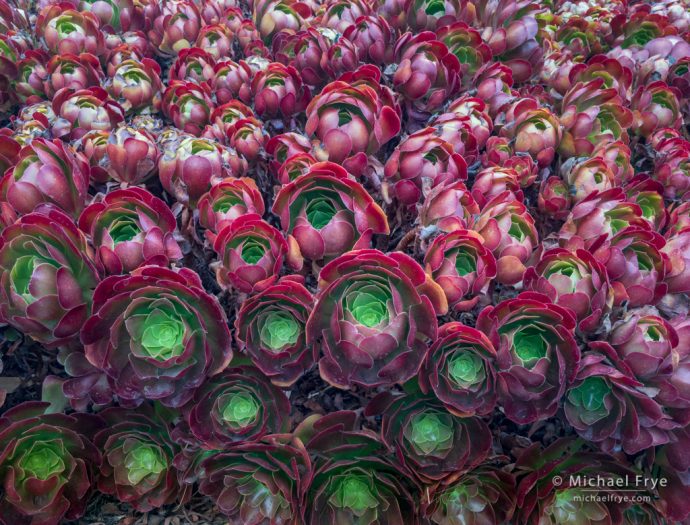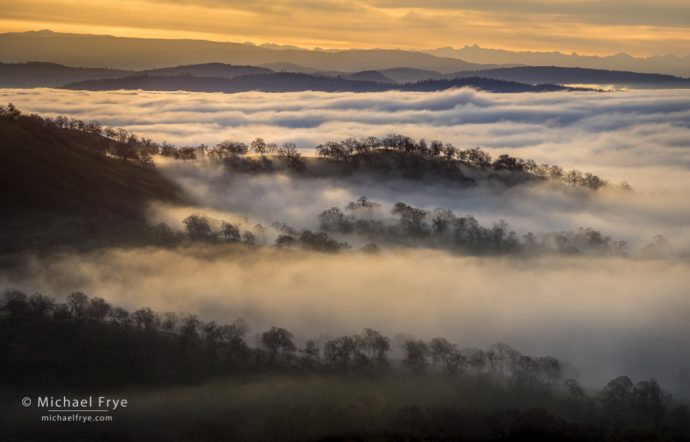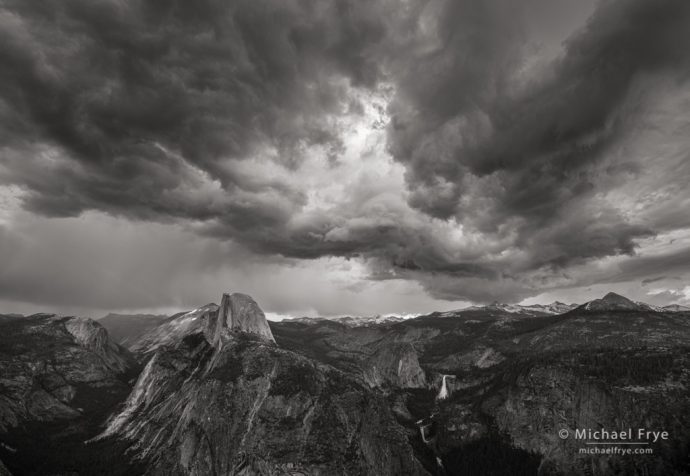Composition
by Michael Frye | Mar 22, 2020 | Composition, Light and Weather

Huntington Gardens – an irresistible pattern! Captured with my iPhone, like all the photos in this post.
I had planned to write this post before the whole coronavirus lockdown. After all, even in “normal” times, many photographers only pick up their cameras when they’re traveling, or taking a workshop. Then when they go on that special trip they’re rusty, and it takes several days just to get back in the groove and start seeing better.
But it doesn’t have to be that way. Here are two simple tips for keeping your photography eye sharp while you’re stuck at home – and even once you go back to your normal routine.
(more…)
by Michael Frye | Nov 3, 2019 | Composition

Autumn lakeshore, Yosemite. 50mm, 1/2 sec. at f/16, ISO 100, polarizer.
I sometimes get asked to recommend a book about composition, and my first suggestion is always Ian Plant’s ebook Visual Flow. Ian understands composition well, presents his concepts clearly, and doesn’t have much use for rules.
The title of the book suggests an important concept, but one that’s often overlooked. I think the best landscape compositions have a natural visual flow. Your eye doesn’t get stuck, but travels freely through the frame, pausing briefly at the key areas.
(more…)
by Michael Frye | Oct 27, 2019 | Composition

Dogwoods in autumn, Yosemite. 118mm, 1/2 sec. at f/16, ISO 1600.
Are you good at picking your best photographs while you’re in the field? Do you always know which ones are going to be your favorites, or do you sometimes find that the ones you thought were going to be great aren’t, while others turn out to be better than you thought?
I’ve been making photographs for a long time, and usually have a pretty good idea of when a photograph will work and when it won’t. Sometimes my field judgements are pretty good, and the images that I most look forward to seeing on a bigger screen turn out to be my favorites. But other times I’m surprised. A photograph I was anxious to see on a large monitor turns out to be disappointing, while another one ends up being a favorite.
(more…)
by Michael Frye | Jul 11, 2019 | Composition

Ridges and peaks above the fog in the Sierra Nevada foothills, California (170mm)
One of my most popular posts was about creating a sense of depth in landscape photographs. In that post I talked about the most common formula for creating depth: a near-far juxtaposition with a wide-angle lens. And then I looked at other, less-common ways of creating depth, like atmospheric effects, perspective lines, and using an elevated vantage point to show a foreground, middle ground, and background. (If you haven’t read that post I recommend doing so; you’ll find it here.)
Creating a sense of depth in a two-dimensional medium like photography can be challenging. There’s no question that the wide-angle, near-far formula works, and in general it’s easier to make photographs with depth using shorter focal lengths rather than longer ones. Telephoto lenses are often better suited to compressing space, and finding two-dimensional patterns and designs out of a three-dimensional world.
(more…)
by Michael Frye | Jun 23, 2019 | Composition

Storm clouds over Half Dome and Nevada Fall from Glacier Point, Yosemite
When we look at a photograph our eyes are usually drawn to light areas, bright colors, and contrast. Therefore I always try to avoid having bright spots, vivid colors, or anything contrasty and eye-catching along the edges of my photographs. I’d rather put the most visually-prominent elements closer to the middle of the picture, to draw the viewer’s eye into the frame, rather than out of it.
I was very conscious of that last Monday when composing the photograph above. Thunderstorms had formed over the Sierra crest, so Claudia and I drove up to Glacier Point, hoping to photograph some interesting weather. We arrived just as a thunderstorm was approaching from the northeast, bringing dark, dramatic clouds. There was no sunlight, but the sky had great textures, and lent a nice, stormy mood to the scene. I used my widest lens (16mm) to include as much of that brooding sky as possible.
(more…)
by Michael Frye | Jun 7, 2019 | Composition

Redwood and rhododendron in the fog, northern California. 90mm, 1.5 seconds at f/16, ISO 400, polarizer.
When teaching composition I emphasize simplicity, because I think the single most common mistake people make is including too much in the frame. I tell students to ask themselves, before composing a photograph, what caught their eye in the first place, and then try to include only that, and nothing else. Pare the image down to its essentials.
The more specific you can get the better. In other words, if a tree caught your eye, what is it about that tree that you find interesting? It’s shape? It’s color? The juxtaposition between the tree and something else? Part of the tree rather than the whole thing? Does something about the tree convey a feeling to you? If you can identify exactly what drew you to a subject or scene you’ll know what you’re trying to say, which is the first, essential step toward effective communication.
(more…)














